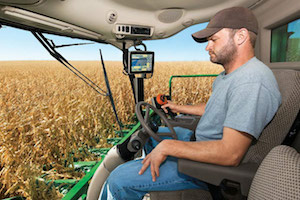Joe Luck, extension precision agriculture engineer at the University of Nebraska-Lincoln, recently highlighted the importance of accurate yield monitor data collection. As he explains, a critical element of yield monitor operation is the calibration of the mass flow sensor, or optical sensor in the clean grain elevator.
Since mass flow sensor readings may be impacted by crop type, moisture content, and test weight, Luck says that it may be worth performing separate calibrations under the differing circumstances. Furthermore, he states that a separate calibration procedure should always be performed for different crops, such as corn or soybeans.
The mass flow sensor calibration process typically involves harvesting two to six small loads of grain and measuring the scale weight of each load.
“Remember that the mass flow sensor is measuring grain flow (lbs/sec) through the clean grain elevator; multi-point calibrations (more than two loads) allow the system to provide more accurate estimates over a range, from low to high flow, through the combine,” Luck says.
There are typically two methods for varying the flow rates for proper mass flow sensor calibration: constant speed with varying cut width, or varying speed with constant cut width. Whichever producers choose, Luck says it’s always important to check throughout the growing season to ensure that debris is not building up around the mass flow sensor.
Newer systems from Deere® and other companies allow for automatic calibration load generation, or reduced calibration loads required. Producers should always read the operator’s manual to learn more about how the automatic calibration load generation works with their specific machine.
